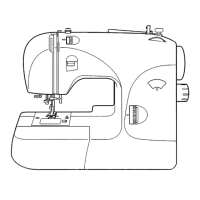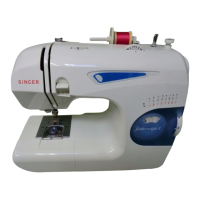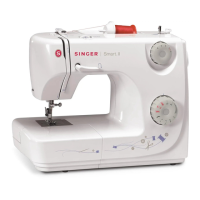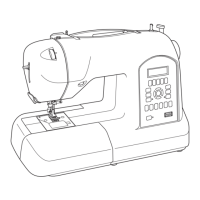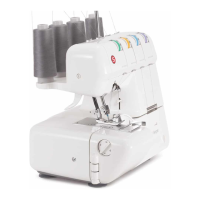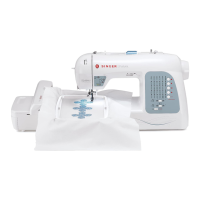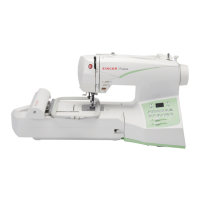Do you have a question about the Singer Futurf II 920 and is the answer not in the manual?
Detailed explanation of the sewing machine's main components and their functions.
List and description of the sewing machine's included accessories.
Instructions for setting up, connecting, and operating the sewing machine.
Guidance on selecting needles, threading, winding, and changing bobbins.
Detailed steps for threading the needle of the sewing machine.
Procedure for winding thread onto the bobbin.
Instructions for removing and replacing the bobbin.
How to adjust machine settings for optimal straight stitching on different fabrics.
Regulating needle-thread tension and setting stitch length for straight stitches.
Techniques for pin basting and placing fabric correctly before sewing.
How to start and end seams correctly, including backstitching.
Tips for keeping seams straight and turning square corners.
Explanation of how stitch patterns are created using discs.
Illustration and description of the ten built-in stitches and their uses.
Selecting stitch patterns and adjusting needle position for various stitches.
Adjusting stitch width and needle-thread tension for zig-zag stitches.
Setting stitch length for Fashion Stitch and Flexi-Stitch patterns.
Aligning pattern starts and adjusting stitch balance for Flexi-Stitch patterns.
Overview and illustration of interchangeable stitch pattern discs and their patterns.
Preparing the machine and threading for twin-needle stitching.
Chart showing stitch patterns, settings, discs, and accessories for twin-needle sewing.
Using the built-in basting stitch for temporary seams and guidelines.
Adjusting tension, preparing, and performing speed basting stitches.
Explanation of chainstitching, its uses, preparation, and tension adjustment.
Detailed procedure for sewing a chainstitch seam.
Creating thread chains and releasing chainstitch from the machine.
Instructions for sewing buttons onto fabric using the machine.
Stitching buttonholes and marking accurate guidelines for placement.
Using the one-step buttonhole foot for quick buttonhole creation.
Adjusting stitch length and balance for optimal buttonhole appearance.
Regulating buttonhole width and length using machine dials and the foot's clamp.
How to create corded or raised buttonholes using filler cord.
Techniques for achieving professional results in garment construction.
Creating invisible hems using the blindstitch and hem guide.
Making regular and continuous-thread darts for shaping garments.
Selecting stitches and techniques for sewing stretch and knit fabrics.
Using Flexi-Stitch patterns and handling knit/stretch fabrics with pressure adjustments.
Using straight stretch stitches for durable, flexible seams in knit fabrics.
Using the Maxi-Stretch stitch for durable, elastic seams in heavy fabrics.
Finishing knit and stretch fabric seams with an overedge stretch stitch.
Applying mock overedge and edge finishes for hems and facings.
Guidance on stitching and handling various types of special fabrics.
Using the Even Feed foot to improve fabric feeding for knits, stretch, and slippery fabrics.
Using the Even Feed foot for various seam types, including topstitching.
Creating smooth, satin-like surfaces using closely spaced zig-zag stitches.
Adding decorative fabric designs using zig-zag or other stitches.
Free-motion embroidery technique using basting settings for beginners.
Repairing worn or torn spots on clothing using various stitching methods.
Using stitch patterns for mending tears and replacing elastic in garments.
Steps to convert the sewing machine to free-arm sewing for tubular areas.
Routine maintenance and cleaning procedures for the sewing machine.
Instructions for safely removing and replacing the sewing machine's light bulb.
Troubleshooting guide for common sewing problems and their solutions.
Overview of special sewing accessories to enhance machine versatility.
Detailed explanation of the sewing machine's main components and their functions.
List and description of the sewing machine's included accessories.
Instructions for setting up, connecting, and operating the sewing machine.
Guidance on selecting needles, threading, winding, and changing bobbins.
Detailed steps for threading the needle of the sewing machine.
Procedure for winding thread onto the bobbin.
Instructions for removing and replacing the bobbin.
How to adjust machine settings for optimal straight stitching on different fabrics.
Regulating needle-thread tension and setting stitch length for straight stitches.
Techniques for pin basting and placing fabric correctly before sewing.
How to start and end seams correctly, including backstitching.
Tips for keeping seams straight and turning square corners.
Explanation of how stitch patterns are created using discs.
Illustration and description of the ten built-in stitches and their uses.
Selecting stitch patterns and adjusting needle position for various stitches.
Adjusting stitch width and needle-thread tension for zig-zag stitches.
Setting stitch length for Fashion Stitch and Flexi-Stitch patterns.
Aligning pattern starts and adjusting stitch balance for Flexi-Stitch patterns.
Overview and illustration of interchangeable stitch pattern discs and their patterns.
Preparing the machine and threading for twin-needle stitching.
Chart showing stitch patterns, settings, discs, and accessories for twin-needle sewing.
Using the built-in basting stitch for temporary seams and guidelines.
Adjusting tension, preparing, and performing speed basting stitches.
Explanation of chainstitching, its uses, preparation, and tension adjustment.
Detailed procedure for sewing a chainstitch seam.
Creating thread chains and releasing chainstitch from the machine.
Instructions for sewing buttons onto fabric using the machine.
Stitching buttonholes and marking accurate guidelines for placement.
Using the one-step buttonhole foot for quick buttonhole creation.
Adjusting stitch length and balance for optimal buttonhole appearance.
Regulating buttonhole width and length using machine dials and the foot's clamp.
How to create corded or raised buttonholes using filler cord.
Techniques for achieving professional results in garment construction.
Creating invisible hems using the blindstitch and hem guide.
Making regular and continuous-thread darts for shaping garments.
Selecting stitches and techniques for sewing stretch and knit fabrics.
Using Flexi-Stitch patterns and handling knit/stretch fabrics with pressure adjustments.
Using straight stretch stitches for durable, flexible seams in knit fabrics.
Using the Maxi-Stretch stitch for durable, elastic seams in heavy fabrics.
Finishing knit and stretch fabric seams with an overedge stretch stitch.
Applying mock overedge and edge finishes for hems and facings.
Guidance on stitching and handling various types of special fabrics.
Using the Even Feed foot to improve fabric feeding for knits, stretch, and slippery fabrics.
Using the Even Feed foot for various seam types, including topstitching.
Creating smooth, satin-like surfaces using closely spaced zig-zag stitches.
Adding decorative fabric designs using zig-zag or other stitches.
Free-motion embroidery technique using basting settings for beginners.
Repairing worn or torn spots on clothing using various stitching methods.
Using stitch patterns for mending tears and replacing elastic in garments.
Steps to convert the sewing machine to free-arm sewing for tubular areas.
Routine maintenance and cleaning procedures for the sewing machine.
Instructions for safely removing and replacing the sewing machine's light bulb.
Troubleshooting guide for common sewing problems and their solutions.
Overview of special sewing accessories to enhance machine versatility.
| Brand | Singer |
|---|---|
| Model | Futurf II 920 |
| Category | Sewing Machine |
| Language | English |
